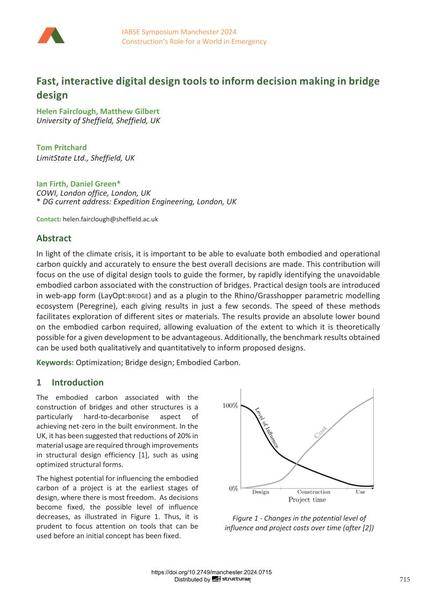Fast, interactive digital design tools to inform decision making in bridge design

|
|
|||||||||||
Bibliographic Details
| Author(s): |
Helen Fairclough
(University of Sheffield, Sheffield, UK)
Matthew Gilbert (University of Sheffield, Sheffield, UK) Tom Pritchard (LimitState Ltd., Sheffield, UK) Ian Firth (COWI, London office, London, UK) Daniel Green (COWI, London office, London, UK) |
||||
|---|---|---|---|---|---|
| Medium: | conference paper | ||||
| Language(s): | English | ||||
| Conference: | IABSE Symposium: Construction’s Role for a World in Emergency, Manchester, United Kingdom, 10-14 April 2024 | ||||
| Published in: | IABSE Symposium Manchester 2024 | ||||
|
|||||
| Page(s): | 715-723 | ||||
| Total no. of pages: | 9 | ||||
| DOI: | 10.2749/manchester.2024.0715 | ||||
| Abstract: |
In light of the climate crisis, it is important to be able to evaluate both embodied and operational carbon quickly and accurately to ensure the best overall decisions are made. This contribution will focus on the use of digital design tools to guide the former, by rapidly identifying the unavoidable embodied carbon associated with the construction of bridges. Practical design tools are introduced in web-app form (LayOpt:BRIDGE) and as a plugin to the Rhino/Grasshopper parametric modelling ecosystem (Peregrine), each giving results in just a few seconds. The speed of these methods facilitates exploration of different sites or materials. The results provide an absolute lower bound on the embodied carbon required, allowing evaluation of the extent to which it is theoretically possible for a given development to be advantageous. Additionally, the benchmark results obtained can be used both qualitatively and quantitatively to inform proposed designs. |
||||
| Keywords: |
optimization bridge design embodied carbon
|
||||

